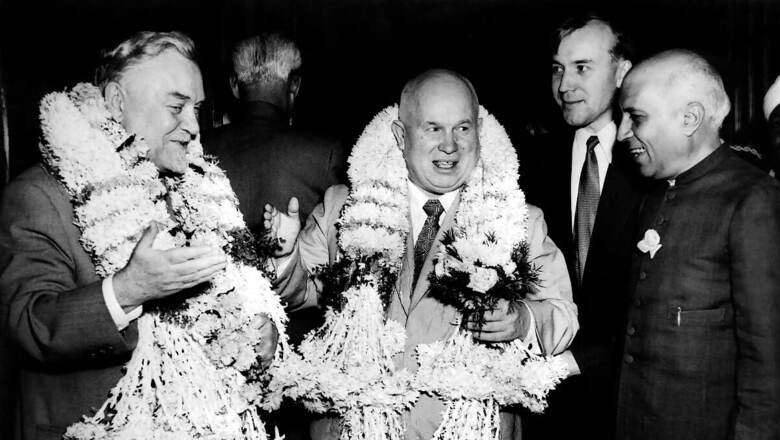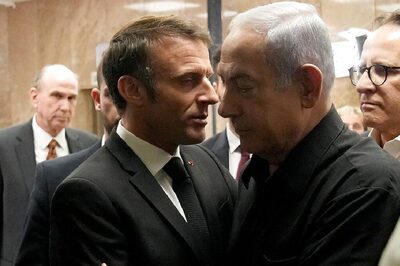
views
Prime Minister Narendra Modi evoked the memories from the early days of Indo-Russian friendship recently in Moscow. He referred to “sar pe lal topi Rusi”, a line from the song Mera Joota Hai Japani penned by Shailendra and sung by Mukesh, from the film Shri 420 (1955) featuring thespian Raj Kapoor in the lead role. The line, to him, encapsulated Indo-Russian friendship, for which he partly credited Raj Kapoor. However, Prime Minister Modi was addressing the Indians residing in Russia. There was hardly any Russian present there.
The NRI/Indian expatriate community has been adding ballast to almost all bilateral foreign visits that Prime Minister Modi has undertaken. However, the mark of real friendship is when the natives of that country, not just expatriate Indians, line up the streets to greet an Indian prime minister. When Nikolai Bulganin and Nikita Khrushchev, the Premier of the erstwhile USSR and First Secretary of the Soviet Communist Party respectively, visited India in November 1955, it was the common Indians who greeted them with boundless enthusiasm. A reel shot by the British Pathé bears testimony to this fact. Another video clip hosted by the Russian Embassy on its YouTube handle captures the resounding welcome the Soviet duo received from the ordinary people of Kolkata (then Calcutta).
Cosmonaut Yuri Gagarin, the first man to go to space, visited India for eight days in November 1961. Crowd followed him everywhere he went, and Mumbai’s (then Bombay) Shivaji Park was jam-packed when he addressed the gathering in Russian, which was simultaneously translated in English. When Jawaharlal Nehru and Gagarin together visited Lucknow University, the spontaneous welcome to the cosmonaut even put the prime minister into shade.
This enthusiasm was not one-way, but reciprocal. In fact, Nehru’s visit to the USSR had preceded the visit of Bulganin and Khrushchev to India by around four months. When Nehru arrived in Moscow on June 7, 1955, for a two-week-long visit, he was welcomed at the airport by all nine leading members of the Soviet government and the central committee of the Communist Party at the Moscow airport. As Nehru was being driven in an open saloon through the streets of Moscow alongside Bulganin, waving crowds of Russians lined up for more than four miles. They clapped their hands above their heads and threw bunches of lilacs and other blossoms.
O.P. Ralhan (not to be confused with his namesake film producer) informs that it was the first time since Victory Day in 1945 that the Moscow crowd had put up such a demonstration of enthusiasm (Jawaharlal Nehru Abroad: A Chronological Study, P.139). Popular fervour touched a new high surrounding Nehru’s visit. Wherever Nehru appeared in public, people gathered in thousands to cheer for him. For instance, thousands of Russians waited for hours to catch his glimpse, when they came to know that Nehru was inside the Indian Embassy for dinner. Popular demonstrations of affection became inconvenient at times. In trying to catch the huge floral bouquets thrown at Nehru, while he was passing in an open car, he sometimes got his fingers hurt by the rose thorns. In Yalta, he joked, “Look, I have shed my blood for Russia” (P.151).
II
If Nehru basked in the glory of Indo-Soviet friendship, one must not forget he was its maker. It might be remembered that Stalin had a very low opinion of India, and the USSR’s outlook on the newly independent nation was discouraging. Stalin had accused India of being a lackey of the Capitalist bloc.
Nehru also held the External Affairs portfolio throughout his years as prime minister. He appointed his sister Vijaya Lakshmi Pandit as the first Ambassador of India to the Soviet Union. Apart from bringing the ignominy of nepotism on Nehru, the experiment failed. Vijaya Lakshmi Pandit’s inability to improve the Soviet outlook on India led her to relinquish the charge in March 1949. Nehru then appointed Dr Sarvepalli Radhakrishnan, the distinguished scholar of Indian philosophy, as India’s ambassador to the USSR. This was a game changer, according to Subimal Dutt, India’s Foreign Secretary (1955-61), and later himself Ambassador to the USSR. Dutt says that Radhakrishnan was “held in high esteem in Moscow’s diplomatic circle and inspired respect in the Soviet Foreign Office”. Radhakrishnan “achieved the distinction, somewhat rare in those days for foreign ambassadors in Moscow, of having been received by Stalin” (With Nehru in the Foreign Office, P.191).
Nehru’s Russian gamble paid off after Stalin passed away in 1953. The Indo-Soviet relationship blossomed in the Khrushchev era. Nehru thus laid the foundation for an all-weather friendship between India and the USSR, which survived the disintegration of the USSR itself. India, though it claimed to be non-aligned, betrayed a bias towards the USSR. Thus, in 1956, whereas India unambiguously condemned the Anglo-French invasion of Egypt over the Suez crisis, its stand against the USSR’s armed intervention in Hungary at around the same time appeared only feeble. On November 4, 1956, India along with the USSR, and other Communist countries, voted against the resolution for investigation into the invasion of Hungary by the UN Secretary-General.
In recent times, India’s dilemma towards taking a definite stand on the Russian invasion of Ukraine is reminiscent of its predicament in 1956. India is wary of offending its all-weather friend, though it remains opposed to war as an instrument of politics.
III
As it would be unfair to deny Nehru the credit for forging Indo-Russian political and diplomatic ties, it would be unethical to omit the name of Khwaja Ahmad Abbas (1914-1987) from any discussion on Indo-Russian cultural ties. Prime Minister Modi is correct about Raj Kapoor being a cultural icon in Russia. However, it was K.A. Abbas who introduced Raj Kapoor in Russia in 1955. Raj Kapoor’s fame in the USSR antedated the film Shri 420 in 1957. It was primarily based on the film Awara (1951), which became a rage throughout the Soviet Union in 1954. K.A. Abbas in his memoirs I am not an Island (1977) likens the runaway success of Brodagya, as the Russian-dubbed version of Awara was called, as a minor revolution in the USSR. From Moscow to Vladivostok, and Arctic Circle to Bokhara, the film captured the Soviet imagination like a “prairie fire”. “Russian and Ukrainian and Georgian teenagers were singing Awara songs in chorus, and one met young people who boasted they had seen the film twenty or thirty times” (I am not an Island, P.372).
Whereas Awara was produced and directed by Raj Kapoor, under his banner R.K. Films, the screenplay and dialogue were written by K.A. Abbas, who co-wrote the film with V.P. Sathe. However, his real contribution was in introducing Raj Kapoor to the Soviet Union, as the leader of the first Indian film delegation to the USSR in 1954. The delegation besides Abbas comprised Bimal Roy, Raj Kapoor, Chetan Anand, Vijay Bhatt, Nargis, Dev Anand, Balraj Sahni, Nirupa Roy, Anil Biswas, Salil Chaudhury, Hrishikesh Mukherjee, Radhu Karmakar etc. Abbas’ position as an intellectual, and proximity to Nehru since the 1930s, stood him in good stead with the Indian as well as the Russian diplomatic fraternity.
Abbas has given a convincing reason why Awara became a rage in the USSR as no film in Soviet history, despite the presence of numerous masterpieces of Russian cinema. The Russians were weary of the war (1939-45) and tired of revisiting the same in books and films in the 1950s. Instead of war, they wanted to see love on screen; they wanted carefree happiness, and someone to make them laugh. Which is why they went crazy over Awara (I am not an Island, P.380).
Later, Abbas co-directed the film Pardesi (1957), an Indo-Soviet joint production, with V.M. Pronin and co-wrote the script with Maria Smirnova. It was based on the film of Afanasy Nikitin, the 15th-century Russian merchant who visited the Vijayanagara Empire and Bahmani Sultanate and left a memoir of his travels. The subject matter of the film is a testimony of the antiquity of Indo-Russian ties going back to the medieval ages.
A few care to remember that it was a Russian who was responsible for starting modern Indian drama. Gerasim Stepanovich Lebedev (1749-1795), translator and musician, established a theatre at Domtala (Ezra Street) in Kolkata, where two plays translated from Russian were performed in Bengali in 1795. The experiment was so promising that it roused the envy of Englishmen, and two of them burnt down the theatre of Lebedev. The British administration, on the whole, was unsympathetic towards him, and he was later expelled from India in 1797. Lebedev later published two books on India viz. A Grammar of Pure and Mixed East Indian Dialects in 1801, and An Impartial Survey of the Systems of Brahminical East India in 1805. He, as D.P. Singhal (1969) informs, cast the first Devanagari type on the command of Tsar Alexander I (India and World Civilization Vol-II, P. 224).
The euphoria in the Indo-Russian relationship witnessed during the 1950s was a product of peculiar circumstances. The bonhomie between the post-Stalin USSR and the young Indian Republic is reminiscent of times when idealism still mattered. They are unlikely to be replicated now. Today, when pragmatism has replaced idealism, passion has gone out of collective life. Thus, we could never recreate the popular warmth of Indo-Russian ties of the 1950s in the 2020s despite Prime Minister Modi meeting Vladimir Putin 17 times in the last 10 years.
Nehru is often dismissed as a vacuous idealist in international relations, whose decisions, especially on China, cost India dearly. No doubt Nehru’s Chinese gamble went awfully wrong, but it went quite right in the case of the USSR. It led to the creation of an all-weather friendship with Russia. Though political and ideological prejudices might come in the way of acknowledging the role of Nehru and K.A. Abbas in strengthening Indo-Russian ties, they are an undeniable matter of history.
The writer is author of the book ‘The Microphone Men: How Orators Created a Modern India’ (2019) and an independent researcher based in New Delhi. Views expressed in the above piece are personal and solely those of the author. They do not necessarily reflect News18’s views.




















Comments
0 comment